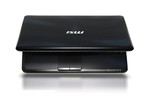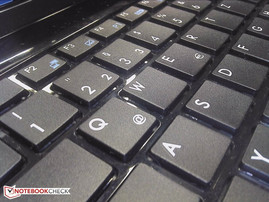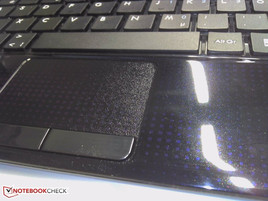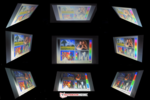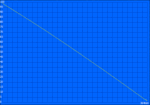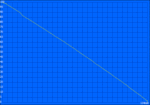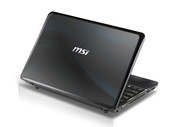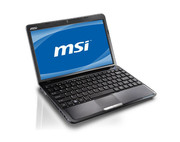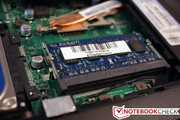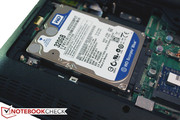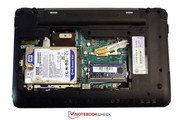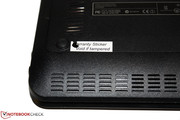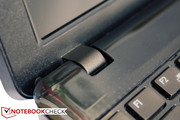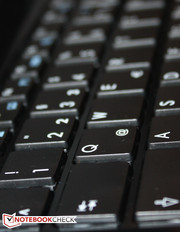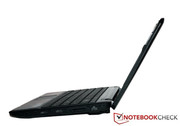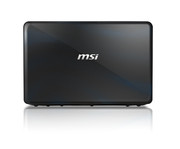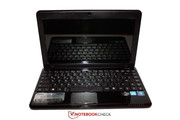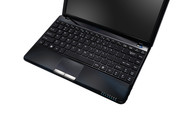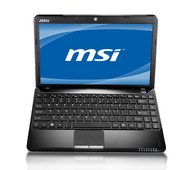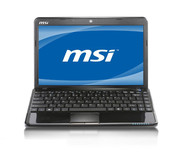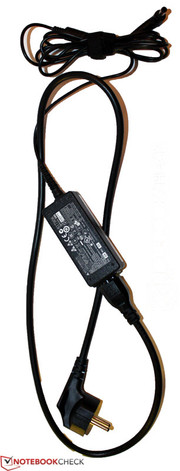Review MSI Wind U270-E4523W7H Netbook
Has the time of 10 inch mites come to an end? The modest pioneer of netbook CPUs, the Intel Atom, is now available as a dual core with integrated graphics chip, and the E-450 installed here now wants to challenge it. MSI launches a netbook of the Wind series onto the market that has an 11.6 inch screen size and a resolution of 1366x768 pixels called U270. It is equipped with the Intel Atom contender, the AMD E-450 that unites a dual core CPU with 1.6 GHz each and the graphics core Radeon HD 6320.
1024x600 pixels was usually the maximum possible for a 10 inch device. It was quite possible to surf on the Internet with such netbooks. However, a few programs or browser applications had their problems with the screen height of 600 pixels because higher windows frequently disappeared underneath the screen's edge. In such a case, the user didn't have another choice but to switch to a compressed 4:3 resolution or to scroll excessively.
Efficiency was also always the highest priority for netbook processors. After all, the small and light netbooks - as the name already indicates - were conceived for surfing and simple office applications. Intel initially developed the energy-efficient Atom processors for this reason. In the meantime, they have received competition from AMD with the C series and now also with the E-series.
The AMD E-450 processor in the Wind U270 is everything but an energy saving model in comparison. In terms of performance and maximum power consumption, it likely currently represents the top of what is being used in netbooks.
Case
The MSI Wind U270 makes a high-end and elegant impression right from the start. The case lid and the wrist rest area are made in a black piano paint look. A dark blue diamond pattern shimmers through it. This however is emphasized more on the manufacturer's pictures than it is visible in reality. The elegant polish has the disadvantage that every touch of a finger and every handling become visible on the surface. The screen's edge is made in a matt, rough black, just like the touchpad and the netbook's bottom.
The plastic case's manufacturing also looks solid and can keep up with the quality of the tried and tested seashell case of Asus Eee PCs.
The fairly tight hinges have a firm hold on the display's angle even in vibrations. However, the display can only be opened to not quite 120 degrees. This could make it difficult for tall persons to find a pleasant viewing angle on their lap.
The slightly wedged position is pleasant, though. It's created by the bulky battery in the base unit. Thus, not only a bit of room between the heat-developing case bottom is created, but typing will be more convenient for the one or other user, as well.
The battery can be easily taken out of the bottom - but accessing the hard disk and memory module isn't possible without a screwdriver.
Connectivity
The U270 also comes with a netbook-typical connectivity. A fast USB 3.0 port, which has become unavoidable in new devices in the meantime, is located on the left next to the HDMI socket. A VGA port is also found on the left beside the DC-in and vent. Both USB 2.0 ports are conveniently not placed directly beside each other on the right. Thus, even bigger USB 2.0 flash drives and connectors can be used at the same time. Moreover, the headphone/speaker and microphone audio jacks as well as an SD card reader, a LAN socket and the Kensington Lock are located here.
Communication
The first thing we unfavorably noticed is that the otherwise high-end and powerful netbook doesn't have Bluetooth, which has become standard even in low-cost models in the meantime. The case features a Bluetooth status LED and a FN key combination, but these remain without effect in the U270. Thus, there's no other possibility but to retrofit this via a USB port should Bluetooth be required. Also, there is no UMTS solution and would also have to be enabled via a stick. The 802.11 b/g/n WLAN module is a must for netbooks, and the Wind U270 is no exception. It can be enabled/disabled via a FN key combination.
Accessories
A webcam is built into the display lid and records videos in 720p HD (high definition). But the MSI unfortunately doesn't have webcam software installed. There is also a microphone located directly beside it. A quick test with Skype delivered a satisfactory audio and video quality and makes it possible to use Skype pleasantly even without a headset.
The "S-Bar" is worth mentioning in view of software. It can be used via the keyboard's FN function with the mouse.
Warranty
MSI grants a two year warranty as of purchase date for the netbook. It includes a free pick-up & return service. There's only one year on the battery and adapter. However, our test device had a warranty label over a screw on the case cover. This is to prevent users from replacing the RAM and hard disk on their own. An inquiry by the manufacturer however revealed that this seal isn't relevant for German devices and the warranty isn't voided when the cover is opened.
Input Devices
Keyboard
The usual chiclet keyboard with the standard 14x14 millimeter wide keys is used in the Wind series models. They have a gap of four millimeters both vertically and horizontally. Besides that, a key drop of about two millimeters enables comfortable touch-typing.
All vital notebook functions can be operated via FN combinations. Among them are sleep, de- and activating the webcam and touchpad as well as switching between monitors - for example when a projector is used. Bluetooth and UMTS symbols are also displayed, but the key combo is without purpose on the U270.
Touchpad
Despite a slightly roughened surface, a pleasant and comfortable control of the cursor is possible and provides the finger with a contrast to the smooth and glossy wrist rest. A swipe of a finger across the 65x52 millimeter surface lets the cursor almost move from one side of the screen to the other in a standard mouse speed. The touchpad enables horizontal and vertical scrolling when its edges are touched for about one second. Multitouch, such as for browser zooming, is not available.
Display
The 11.6 inch screen lets the U270 stand out from the mass of 10 inch netbooks and, with 1366x768 pixels in a 16:9 aspect ratio, it supplies a higher resolution than the 10 inch screens, which have 1024x600 pixels. This means a significant plus of work quality for the user in contrast to the 10 inch devices. Alike its precursor, the Wind U160 netbook has a high-gloss screen which makes outdoor use difficult due to reflections.
Higher resolutions can be displayed on external monitors via the VGA and HDMI port. A Full HD resolution (1080p) of 1920x1080 pixels is possible depending on the monitor, and thus the mite could also render corresponding Blu-Ray movies.
| |||||||||||||||||||||||||
Brightness Distribution: 85 %
Center on Battery: 165 cd/m²
Contrast: 217:1 (Black: 0.76 cd/m²)
In our laboratory test of screen brightness, the LED backlit display delivered a poor to average result. The average brightness of 165.8 cd/m2 is a bit better than that of the 10 inch Wind U160, but the reflective screen can't keep up with the "matt members" of the Asus Eee netbooks. On the other hand, the neither too high nor low black value of 0.76 cd/m2 is agreeable. It supplies a feasible contrast ratio of 217:1.
We have to note that the measured deviations are negligibly slight to comparable netbooks and will likely hardly be noticed by the user. The screen in the Wind U270 proved to always be viable indoors in the practical test. The lowest energy saving brightness was still suitable for working in dark rooms and the screen's highest brightness setting was also sufficient in brightly illuminated rooms. However, a reasonable working outdoors is hardly possible due to the reflective display and the only moderate brightness.
Performance
The processor, AMD E-450, takes care of the performance. Intel's Atom counterpart, the D525 (e.g. used in the Asus Eee PC 1215N), has a somewhat faster CPU, but only a DirectX 9 graphics with the Intel GMA 3150. The E-450, integrated in the AMD Radeon HD 6320, offers DirectX 11 support. However, the MSI Wind U270 doesn't mutate into a "gaming netbook" for up to date games with that.
Processor
Thanks to the brand new dual core processor, AMD E-450, the MSI Wind U270 stands out from comparable netbooks in almost all Cinebench scores. The E-350 precursor is only beaten slightly, as expected. It's found in the aforementioned HP Pavilion dm1-3180eg, as well as the foreign version of the MSI Wind U270, which were launched before the German version. The E-350 is only clocked lower by 60 MHz. The E-450 is only surpassed by one other netbook processor. The Intel Atom D2700, which can be found in the Asus Lamborghini Eee PC available for about 150€, achieves 0.7 points in the Cinebench 64 bit CPU test while the E-450 scores 0.55 points.
The latest CPUs, such as the built-in E-450, are however no longer a competition for the more widespread Intel Atom N550. The AMD CPU's score is doubled in contrast to the older Intel equivalent in Cinebench Single Thread Rendering.
The lavish performance is of course also power consuming. The AMD E-450 doesn't exactly count to the most energy efficient models among netbooks with a maximum power consumption (TDP) of 18 watts. A more energy saving dual core chip, such as in the Intel Atom N570 installed in the new Asus Eee PC R051, only consumes a maximum of 8.5 watts (TDP).
System Performance
The Windows 7 performance index already indicates an above average benchmark score for up to date netbooks. The Wind U270 surpasses all current 12 inch devices from Asus, for example the Eee PC 1215B or the HP Pavilion dm1-3180eg - both still with the previous APU.
We used PCMark Vantage as another reference for the "all-round performance". With a result of 2268 points, the aforementioned HP Pavilion is only placed higher by a hair's breadth with 9 points - despite the (slightly) weaker APU, E-350. With 1788 points, the Eee PC lags behind the three compared netbooks with the weakest (but most energy efficient) processor, the AMD C-50.
The U270's performance makes a good impression in the practical test: The netbook boots fairly quickly, wakes up fast from standby mode and even larger websites aren't a problem. Until now, the user paid for the modest mobility with a few seconds of delay when for example an office application was opened. Not so with the new Wind: The subjectively perceived fast work speed, as known from the "bigger brothers", was possible without difficulties.
| PCMark Vantage Result | 2268 points | |
| PCMark 7 Score | 991 points | |
Help | ||
Mass Memory
MSI has doubled the memory capacity of the until now sparsely equipped Wind netbooks with a 320 GB hard disk. The 5400 rpm Western Digital hard disk, WDC WD3200BPVT-22ZES, is used in the U270. We determined the hard disk's performance with HDTune and CrystalDiskMark 3.0 and recorded quite good read speeds in both benchmarks. They are usually slightly better than many hard disks installed into the latest Eee PCs. Again, the U270 is surpassed only by the HP Pavilion dm1-3180eg, which has a 7200 rpm hard disk.
Graphics Solution
The E-450 chip has an AMD Radeon HD 6320 graphics that branches off 384 MB from the main memory and runs with a default clock rate of 500 MHz. The only difference to the precursor is that the Radeon HD 6310 can automatically overclock up to 600 MHz.
The HD 6320 achieved a decent result for a netbook in our benchmark with 3DMark 06: with 2478 points, the GPU easily excels its "smaller brother", the Radeon HD 6310, with 2072 points. The former Intel leader Atom N550, for example, in the Asus Eee PC 1015PEM, only achieves 147 points with the integrated Intel GMA 3150 graphics. Pretty scanty for today's standards. No more than 720p HD movies ran on this Eee PC with restrictions. A smoother 1080p playback was no longer a problem with the dedicated graphics unit, Nvidia ION 2, as it is found with the Atom N550 in the Asus Eee PC 1015PN. However, this chip doesn't achieve half of the points that the Radeon HD 6320 manages with 1155 points in this benchmark.
| 3DMark 06 Standard Score | 2478 points | |
| 3DMark Vantage P Result | 914 points | |
| 3DMark 11 Performance | 320 points | |
Help | ||
HD Video and Gaming Performance
The Wind U270 renders all HD video with a 720p and 1080p resolution smoothly without restrictions and doesn't even reach its full capacity. The task manager shows a processor load of about 40% in the maximum energy saving mode, where the processor clock is halved (830 MHz). The dual core processor only manages a capacity of about 11% without energy saving options. The VGA and HDMI ports both support a Full HD resolution of 1920x1080 pixels. Thus, nothing stands in the way of HD entertainment with a corresponding 1080p monitor or TV.
To check the gaming suitability, we briefly played StarCraft II. We assessed the average fps (frames per second) during a scripted in-game sequence with the tool FRAPS. With 46 fps, the game is absolutely smoothly playable with the minimum image quality and resolution (1024x768). However, the netbook only manages an average of 13 fps in medium graphic settings and the native screen resolution of 1366x768 pixels. This would be playable with gritted teeth, but it wouldn't be fun for long. The best compromise would be low graphic settings in the native resolution - this would make Starcraft II still very playable with an average of 35 fps.
The AMD Radeon HD 6320 is probably the strongest graphics card that is currently feasible for gaming in the netbook range. And although games from the past years could be possible with certain restrictions on the MSI Wind U270, netbooks just aren't made for gaming, as this model proves.
Buyers looking for a gaming suitable notebook with the same screen size and resolution will have to turn to the Alienware M11x R3. But, they will also have to pay almost twice as much in this case. The gaming notebook is available for a street price starting at 699€.
| low | med. | high | ultra | |
|---|---|---|---|---|
| StarCraft 2 (2010) | 46 | 13 |
Emissions
System Noise
Despite the 12 inch model's good performance, our objective lab assessment "only" showed average rates for system noise. The Wind U270 is well in the range of weaker single core devices from the netbook category with a minimum of only 30.5 decibels. However, where others only reach about 35 decibels in full load, we measured over 40 decibels in the U270. This is also very audible in practical use. The fan's permanent whine can clearly be heard. Moreover, we noticed that the fan management adjusts well to the current load in the practical test.
Noise level
| Idle |
| 32.2 / 32.4 / 32.6 dB(A) |
| HDD |
| 33.1 dB(A) |
| Load |
| 37.8 / 40.8 dB(A) |
 | ||
30 dB silent 40 dB(A) audible 50 dB(A) loud |
||
min: | ||
Temperature
Our measured temperature rates confirm the fan management's good impression. The processor doesn't exceed 68 degrees Celsius even under permanent full load. The hard disk also only reaches 33 degrees. The temperature climbs to a maximum of 42.1 degrees on the bottom. However, since permanent load will hardly ever occur in real life, the bottom's temperature will usually be lower. Thus, it's possible to pleasantly work with the netbook on the lap even when executing performance-intensive applications. The heat dissipation is only noticed on the left wrist rest area. However, it won't be perceived as excessively hot with 32.2 degrees.
The CPU doesn't surpass 50 degrees in energy saving mode and all rates on the case are far below 30 degrees. It's probable that more body heat is passed on to the device than vice versa during use. An operating temperature is thus not noticeable in this mode.
(+) The maximum temperature on the upper side is 33.1 °C / 92 F, compared to the average of 33.1 °C / 92 F, ranging from 21.6 to 53.2 °C for the class Netbook.
(±) The bottom heats up to a maximum of 42.1 °C / 108 F, compared to the average of 36.6 °C / 98 F
(+) In idle usage, the average temperature for the upper side is 24.2 °C / 76 F, compared to the device average of 29.8 °C / 86 F.
(+) The palmrests and touchpad are reaching skin temperature as a maximum (33.1 °C / 91.6 F) and are therefore not hot.
(-) The average temperature of the palmrest area of similar devices was 29.3 °C / 84.7 F (-3.8 °C / -6.9 F).
Speakers
Good sound was never a trait that a netbook could boast with. It is even frequently poor in midrange notebooks. This is an attribute reserved for expensive and big multimedia notebooks (and will remain that way). Listening to music or watching a video was hardly possible on the first 10 inch devices without a headphone or active speakers due to the low volume. The built-in speakers of the Wind U270 however offer a sufficient playback for watching a video or listening to music when the user is the sole listener in a quiet room. Nevertheless, they lack bass and volume for a good sound experience outdoors, in busier rooms or in the train. The speakers' maximum volume is simply too thin and quiet for this. Headphones or active speakers can quickly remedy that, though.
Battery Life
Power Consumption
The appealing performance of netbooks has its price: Gigantic power consumption. Although the MSI Wind U270 consumes as much power as other dual core netbooks in idle, the consumption of 26 watts in load is significantly higher than the netbook category's average.
For example, the similar HP Pavilion dm1-3180eg uses about a third less than the Wind. The latest (and weaker) 10 inch Asus Eee PC R051PX netbook consumes a third less than the U270 during load and is also noticed in the good battery life.
Only the Asus Eee PC 1215T is weaker and consumes a few watts more than our Wind U270 during load.
| Off / Standby | |
| Idle | |
| Load |
|
Key:
min: | |
Battery Life
MSI promises seven hours of battery life in idle. However, we didn't measure this no matter what we tried. We determined no more than 6 hours and 4 minutes in idle with the lowest screen brightness, disabled WLAN module and maximum energy saving settings. And this although, as mentioned above, the processor's clock is halved in the so-called "Office Mode". We executed three measurements, whereby a maximum of 364 minutes was achieved. The other two were only below that by a few minutes.
Of course, permanent idling, and consequently the maximum battery life, isn't realistic for practical use. Therefore, we simulated routine use on the U270 with medium screen brightness, WLAN, office tasks and Internet surfing. The battery didn't surpass a battery runtime of 5 hours.
The netbook still lasted for 2 hours and 14 minutes during full CPU load, which is just as unlikely as permanent idle in practical use. It however represents the minimum battery life.
Verdict
MSI is going for it and scrapes the category border of netbooks and subnotebooks with the Wind U270. However, the device still lacks a bit of power and equipment for the latter. Additionally, the very fair street price of currently just under 400€ sooner implies the netbook category. Thanks to the adequate dual core processor, the work speed under Windows 7 is pleasant and, in contrast to many netbook contenders, the U270 conveys a real notebook feel - not least due to the 12 inch screen.
But major compromises have to be made in terms of mobility: The moderate battery life is restricting here, and the lack of Bluetooth has to be retrofitted via USB when required. The average screen brightness can't compensate the drawback of the reflective screen either. Thus, other netbooks would be more suitable for outdoor use.
The MSI Wind U270 seems to be sooner made for those who want to use a netbook almost exclusively indoors - ideally in AC mode - because they don't always want to carry a 3 kilogram device around with them. The nearly 1.5 kilogram light netbook is in no way inferior to bigger and heavier notebooks when it comes to routine office applications and Internet surfing.




